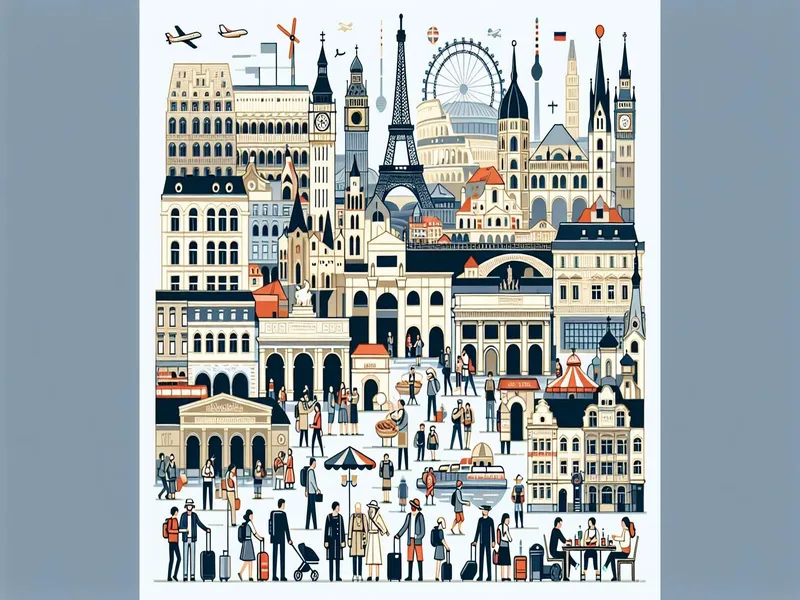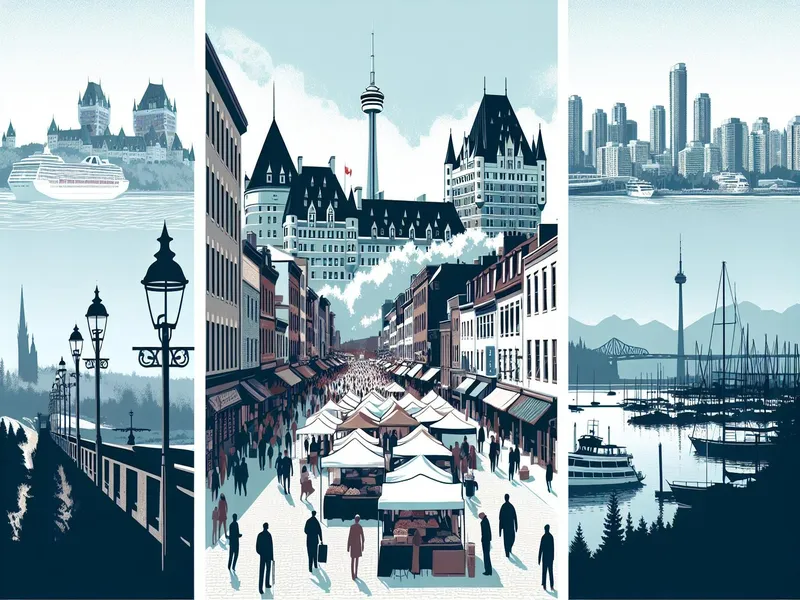
Whether you’re captivated by the art of Paris, the history of Rome, or the traditions of Prague, cultural travel in Europe offers endless opportunities to immerse yourself in diverse experiences. But where do you start, and how can you make the most out of your journey?
Ignoring the importance of planning can lead to missed opportunities and a less enriching experience. Without proper guidance, you might overlook hidden gems or waste time on tourist traps that don’t capture the true essence of European culture.
I’ve spent years exploring Europe’s cultural world, uncovering unique spots that offer authentic experiences. From local festivals to historic landmarks off the beaten path, my insights will help you create an itinerary that’s both fulfilling and memorable.
Different travelers have different needs—some crave artistic inspiration while others seek historical knowledge. I’ll tailor this guide to address various interests ensuring it’s relevant whether you’re an art lover, history buff, or simply curious about new cultures.
I understand how overwhelming it can be to plan such a trip which is why I’m here to help you navigate through it all confidently. Let’s begin on this cultural adventure together making sure every moment counts! For more tips on planning activities during your travels check out our comprehensive guide here.
Exploring Cultural Travel In Europe
Traveling in Europe feels like flipping through a history book while munching on local delicacies. Imagine standing in front of the Eiffel Tower, croissant in hand, or wandering through Rome’s ancient ruins with gelato melting down your fingers. Yep, cultural travel in Europe is that dreamy.
Iconic Cities and Their Hidden Gems
Let’s talk about Paris, Rome, and Prague. These cities are like the rock stars of European travel. They’ve got all the big hits—Eiffel Tower, Colosseum, Charles Bridge—but their B-sides (the hidden gems) are just as good.
- Paris: Sure, climb up the Eiffel Tower for that killer view. But don’t miss out on strolling through Le Marais district. It’s packed with quirky boutiques, vintage shops, and some seriously cool street art.
- Rome: The Colosseum is incredible but venture to Trastevere for a more authentic Roman experience. Picture narrow alleys lined with ivy-clad buildings and cozy trattorias serving homemade pasta.
- Prague: Charles Bridge at sunrise will take your breath away but explore the Žižkov neighborhood to see a different side of Prague—gritty yet charming with its eclectic bars and cafes.
Planning Your Cultural Itinerary
Here’s where my years of exploring come in handy—planning! Trust me; you don’t want to land in Barcelona only to find out Picasso Museum’s closed on Mondays.
- Research Ahead: Websites like TripAdvisor or Lonely Planet can help you figure out what’s open when.
- Mix It Up: Balance iconic landmarks with lesser-known spots so you’re not stuck elbow-to-elbow with tourists all day.
- Local Events: Check if there are any festivals or events happening during your visit. I stumbled upon a medieval festival in Tuscany once—it was unforgettable!
Art and History Buffs Rejoice!
Europe’s got enough museums to keep an art lover busy for decades! If you’re into impressionist paintings or Renaissance sculptures, you’ll be in heaven here.
- Louvre (Paris): Home to Mona Lisa—yeah she’s smaller than you’d think but still awe-inspiring.
- Uffizi Gallery (Florence): This place has Botticelli’s “The Birth of Venus” among other masterpieces.
- Museum Island (Berlin): A cluster of five world-class museums including Pergamon Museum which houses ancient artifacts from around the globe.
Personal Anecdotes & Tips
I remember getting lost in Venice’s labyrinthine streets one evening—it turned out to be magical rather than stressful because every corner had something beautiful waiting—a tiny bridge over a canal glistening under moonlight or an old man playing accordion filling air with soulful melodies.
So next time you’re planning a trip across Europe consider taking those unexpected turns—they often lead to the most memorable experiences!
Must-Visit Cultural Destinations

Visiting Europe’s cultural destinations feels like stepping into a living museum. From ancient ruins to stunning art galleries, there’s so much to discover.
Historical Landmarks
Europe is brimming with historical landmarks that transport you back in time. Imagine walking through Rome’s Colosseum, where gladiators once battled for glory. This iconic structure offers a glimpse into the grandeur of ancient Roman life. Or picture yourself standing before Berlin’s Brandenburg Gate, which has witnessed centuries of history from Napoleon’s invasion to the fall of the Berlin Wall.
Other must-see landmarks include:
- Stonehenge in England: A mysterious prehistoric monument.
- Acropolis in Athens: The heart of ancient Greek civilization.
- Versailles Palace in France: An extravagant symbol of royal opulence.
Art Museums And Galleries
For art lovers, Europe is paradise. You can marvel at masterpieces from every era and style. Take Paris’ Louvre Museum—home to the Mona Lisa and countless other treasures. Each visit uncovers something new, whether it’s an Egyptian artifact or a Renaissance painting.
In Florence, the Uffizi Gallery boasts works by Botticelli and Michelangelo. It’s like diving into a pool of artistic genius! And don’t forget Amsterdam’s Van Gogh Museum, offering an intimate look at Vincent van Gogh’s life through his vibrant canvases.
Must-visit museums include:
- The Prado in Madrid: Spanish art galore.
- Rijksmuseum in Amsterdam: Dutch Golden Age highlights.
- Tate Modern in London: Cutting-edge contemporary pieces.
UNESCO World Heritage Sites
UNESCO World Heritage Sites are spots deemed invaluable to humanity—both culturally and naturally. Exploring these sites adds depth to any trip as they often reveal layers of history and culture you might miss otherwise. For instance, stroll along Prague’s Old Town Square with its Gothic churches and baroque buildings—it’s like walking through a fairy tale!
Another gem is Spain’s Alhambra Palace—a stunning blend of Islamic architecture and lush gardens set against the backdrop of Sierra Nevada mountains. Or wander through Edinburgh’s Old Town with its medieval streets that inspired J.K. Rowling’s Harry Potter series.
Notable UNESCO sites:
- Cinque Terre in Italy: Colorful cliffside villages.
- Pyramids of Giza (Egypt): Technically outside Europe but easily accessible.
- Mont-Saint-Michel in France: An island commune with breathtaking views.
Unique Cultural Experiences

When you’re traveling across Europe, it’s the unique cultural experiences that make each city unforgettable. Let’s jump into some of these amazing opportunities.
Traditional Festivals
Europe’s traditional festivals are a must-see. Imagine dancing in the streets during Spain’s La Tomatina, where locals and visitors throw tomatoes at each other in a fun-filled food fight. Or picture yourself at Oktoberfest in Germany, enjoying hearty beers and pretzels while dressed in lederhosen or dirndl. These festivals let you experience local customs firsthand and create memories you’ll cherish forever.
Culinary Delights
European cuisine offers culinary delights that are sure to tantalize your taste buds. In Italy, savor fresh pasta dishes like spaghetti carbonara with creamy sauces you’ll never forget. Head to France for buttery croissants and exquisite pastries that melt in your mouth. Don’t miss out on Belgian waffles either—they’re crispy on the outside and soft inside, perfect with a dollop of whipped cream or fresh fruit.
Local Customs And Traditions
Engaging with local customs and traditions enhances any trip. For example, in Greece, it’s customary to break plates during celebrations—a practice meant to ward off evil spirits. Meanwhile, in Scotland, you might participate in ceilidh (pronounced kay-lee), a social dance event filled with lively music and energetic moves. Embrace these traditions to truly immerse yourself in the culture you’re visiting.
Tips For Planning A Cultural Trip
Planning a cultural trip to Europe can be an exciting yet overwhelming experience. To make your journey unforgettable, follow these practical tips.
Research And Planning
Start by researching the destinations you want to visit. Look up must-see sites like the Louvre in Paris and hidden gems such as Le Marais district. Check for local events that align with your interests—nothing beats catching a traditional festival like Oktoberfest in Munich! Create a flexible itinerary balancing iconic attractions and lesser-known spots. Avoid tourist traps by reading blogs, forums, and reviews from fellow travelers. I once discovered the charming Žižkov neighborhood in Prague thanks to a travel blog; it was a highlight of my trip!
Packing Essentials
When packing for your cultural adventure, consider the climate and activities planned. Bring comfortable walking shoes; European cities are best explored on foot. Pack versatile clothing layers to adapt to varying weather conditions. Don’t forget essentials like travel-sized toiletries, an umbrella, and power adapters (European outlets differ from American ones!). A small backpack or crossbody bag is handy for day trips—just ensure it’s secure against pickpockets. Trust me, having all these items made my visits to places like Rome’s Colosseum much smoother.
Budget Management
Managing your budget effectively ensures you can enjoy all that Europe offers without financial stress. Start by setting a realistic daily budget covering meals, transportation, entry fees, and souvenirs. Use apps or spreadsheets to track expenses—I used one during my last trip and found it immensely helpful! Opt for public transport instead of taxis; many cities offer affordable passes for tourists. Consider staying in hostels or Airbnb accommodations if hotels stretch your budget too thinly—they often provide more authentic experiences anyway.
Sustainable Cultural Travel
Sustainable travel isn’t just a buzzword; it’s a way to ensure that our adventures don’t harm the places we love. When exploring Europe’s rich cultural landscapes, it’s important to think about how our travels impact local communities and the environment.
Supporting Local Communities
When you visit Europe, one of the best ways to give back is by supporting local businesses. Instead of hitting up big chain stores or restaurants, try shopping at local markets or dining in family-owned eateries. For example, I had an amazing experience in Lisbon when I stumbled into a small bakery run by an elderly couple who treated me like family.
- Stay in locally-run accommodations like boutique hotels or B&Bs.
- Buy souvenirs from local artisans rather than mass-produced items.
- Participate in community-led tours which offer authentic insights.
Supporting locals not only enriches your travel experience but also ensures that tourism benefits those who need it most.
Eco-Friendly Travel Practices
Traveling sustainably also means being mindful of your environmental footprint. Simple choices can make a significant difference:
- Use Public Transport: Europe has an excellent public transport system. Trains, trams, and buses are not only eco-friendly but also offer great views of the countryside.
- Pack Reusable Items: Bring along reusable water bottles and shopping bags to reduce waste.
- Stay Longer in One Place: Instead of hopping from city to city every day, immerse yourself fully in one location for a longer period—this reduces carbon emissions from frequent travel.
Once, while visiting Amsterdam, I rented a bike instead of using taxis or rideshares. Not only was it better for the environment, but cycling through the city’s canals felt incredibly freeing!
By incorporating these practices into your travel plans, you’re contributing to preserving Europe’s beauty for future generations while still enjoying everything it has to offer.
Wrapping Up
Exploring Europe’s rich cultural world is a journey like no other. From iconic landmarks to hidden gems each city offers unique experiences that cater to all interests. With careful planning and an open mind travelers can truly immerse themselves in the local culture savoring everything from art and history to festivals and culinary delights.
By supporting local businesses and practicing eco-friendly travel we not only enrich our experiences but also help preserve these beautiful destinations for future generations. Embrace the adventure spontaneity often leads to the most unforgettable moments. Happy travels!